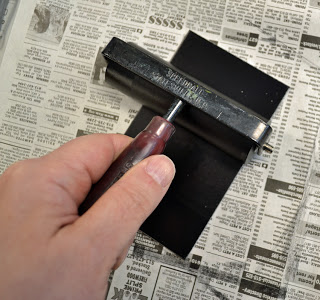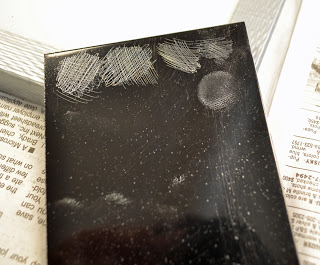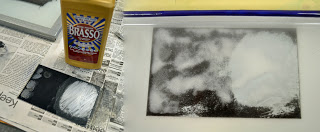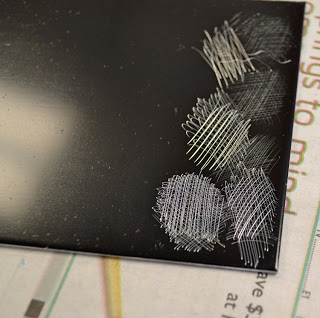Tiger Lily Press is gradually moving towards
non-toxic print methods and we’ve just started
exploring different types of etching grounds that
don’t require harmful solvents to remove.
An order of B.I.G. (Baldwins Ink Ground) just
arrived from Wales, UK. The etching ground
is made in Trefeglwys Print Studio by
Andrew Baldwin.
Today was my first chance to experiment with it
by applying (and removing it) from a small test plate.
The ground is fairly thick and tacky, just a small amount is spread out
on an inking slab and rolled out thinly with a brayer.
The plate was thoroughly cleaned and de-greased before
applying the ground.
Mistake #1 was applying the ground with
newspaper under the plate. I discovered that
tiny paper fibers and specks were transferred
to the ground causing it to be somewhat uneven.
BIG can be used as a soft ground
right after applying it to the plate.
If the plate is heated after application,
it will harden and acts like a traditional hard ground.
After I applied BIG to my plate, I set it on the hotplate
for 5 minutes to harden it. I wasn’t sure if that would be long enough,
but our hotplate is erratic and I didn’t want to burn the ground.
Well, 5 minutes wasn’t quite enough. I was able to easily draw
lines through it with a scribe, and it was also just soft enough to
make an impression with my finger.
You can see the paper specks on the ground in this photo.
At this point, I thought I’d try to clean it off and redo it
instead of attempting to etch the plate.
The instructions offer several options to remove it,
including Brasso. Yes, I tried that first and it worked
quite well. Although not wanting to waste expensive Brasso,
I tried option #2 which is soaking the plate in
a hot water bath with washing soda crystals. After soaking
for approx. 15 minutes, I began to scrub with a toothbrush.
That took a while and I wasn’t pleased as much with the results.
The folks at Zea Mays recommend using
D-Solve citrus cleaner, so that may be option #3
for doing a better job of removing the ground.
So I re-applied the ground, this time
placing the plate on a clean ink slab instead of newsprint
as I rolled it on the plate. This yielded much cleaner results.
I then placed it back on the hotplate and left it
for 15 minutes this time.
After allowing the plate to cool off, I was able to use
a scribe to make a series of crosshatched marks.
(Mistake #2 was not cleaning the roller off sooner! The ground
dried quicker than I expected, making it difficult to remove.
A coat of Brasso rubbed into the roller eventually
removed it)
(Mistake #2 was not cleaning the roller off sooner! The ground
dried quicker than I expected, making it difficult to remove.
A coat of Brasso rubbed into the roller eventually
removed it)
I was very impressed with the “feel” of the ground as I
worked on it. No chipping, flaking or peeling at all.
It has promise!!
It has promise!!
So that concludes day #1 of experimenting with BIG ground,
more to come!




